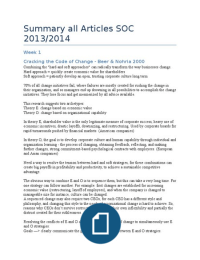Summary all Articles SOC
2013/2014
Week 1
Cracking the Code of Change - Beer & Nohria 2000
Combining the "hard and soft approaches" can radically transform the way businesses change.
Hard approach = quickly create economic value for shareholders
Soft approach = patiently develop an open, trusting corporate culture long term
70% of all change initiatives fail, where failures are mostly created for rushing the change in
their organization, and so managers end up drowning in all possibilities to accomplish the change
initiatives. They lose focus and get mesmerized by all advice available.
This research suggests two archetypes:
Theory E: change based on economic value
Theory O: change based on organizational capability
In theory E, shareholder value is the only legitimate measure of corporate success, heavy use of
economic incentives, drastic layoffs, downsizing, and restructuring. Used by corporate boards for
rapid turnarounds pushed by financial markets. (American companies)
In theory O, the goal is to develop corporate culture and human capability through individual and
organization learning - the process of changing, obtaining feedback, reflecting, and making
further changes, strong commitment-based psychological contracts with employees. (European
and Asian companies)
Need a way to resolve the tension between hard and soft strategies, for these combinations can
create big payoffs in profitability and productivity, to achieve a sustainable competitive
advantage.
The obvious way to combine E and O is to sequence them, but this can take a very long time. For
one strategy can follow another. For example: first changes are established for increasing
economic value (restructuring, layoff of employees), and when the company is changed to
manageable size for instance, culture can be changed.
A sequenced change may also require two CEOs, for each CEO has a different style and
philosophy, and changing this style to the needs of organizational change is hard to achieve. So,
reasons why CEOs don’t survive restructuring, partially their own inflexibility and partially the
distrust created for their ruthlessness.
Resolving the conflicts of E and O along the six dimensions of change to simultaneously use E
and O strategies:
Goals —> clearly communicate the goals and show tension between E and O strategies.
, Leadership —> communicate direction from top and engage people below to encourage
dialogue, to create respect and emotional commitment.
Focus —> simultaneous focus on hard and soft sides. For instance, removing hierarchical layers
in structure, can be both E and O strategies.
Process —> Spontaneity. Encourage experimentation and evolution, promote learning in a risk-
free zone.
Reward system —> Let incentives reinforce change, not drive it. Compensation is a double-
edged sword. Money can motivate managers, but also hamper teamwork, learning. Resolving
this through applying E incentives in an O way. Variable pay to reward commitment (through
high involvement).
Use of consultants —> as expert resources who empower employees. Specialized knowledge and
technical skills from consultants, it should be figured out how to use those resources without
abdicating leadership of the change effort.
Leading Change: Why Transformation Efforts Fail - Kotter 1995
The most general lesson to be learned from the more successful cases is that the change process
goes through a series of phases that, in total, usually require a considerable length of time.
Skipping steps creates only the illusion of speed and never produces a satisfying result. A second
very general lesson is the critical mistakes in any of the phases can have a devastating impact,
slowing momentum and negating hard-won gains.




